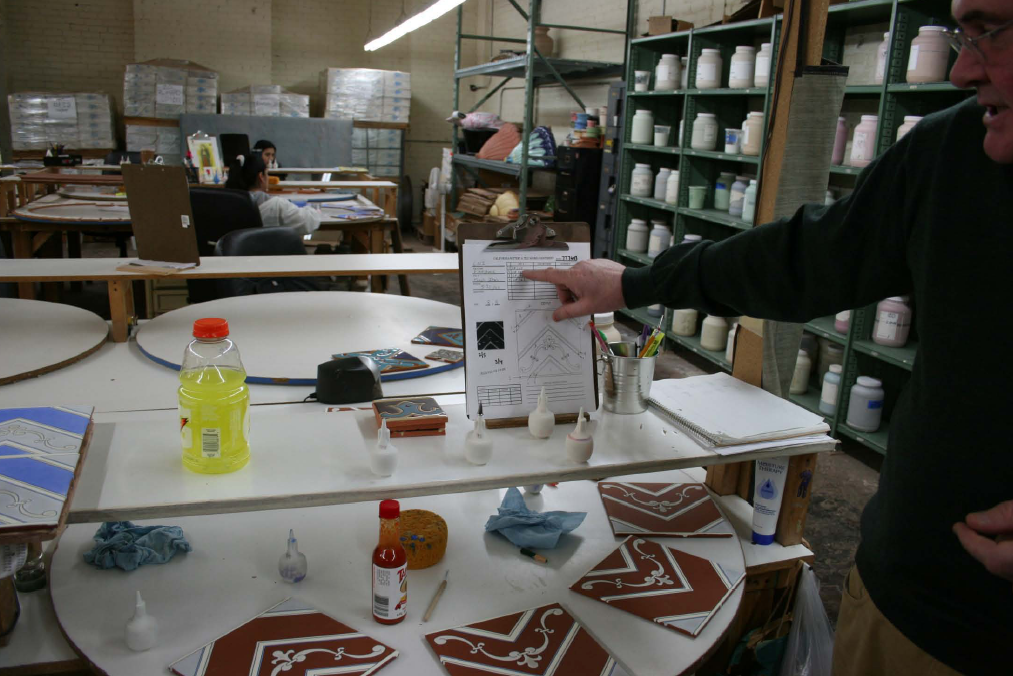Creation of Custom Shapes from Raw Clay Materials
Our bisk meets specifications for the field tile component of an installation. Large surface areas will usually be covered by tiles of standard sizes. The decorative component(s), however, often call for custom shapes, sizes, and varied thickness to accommodate a particular design or pattern. For example we can produce a high relief decorative tile in a triangular shape, or custom architectural features such as a fountain spout or mantle support.

Creation and Preparation of Custom Designs
The decorative component of a project starts with a design in the form of an outline image, which can be created by hand or taken from our on line library of Line Drawings and then colorized according to client specifications in our art department’s computer graphics systems or with the help of Malibu Tile Painter™.

Silk-Screening
Silk-screens are used to transfer the outlined image onto the bisque, creating a pattern and guide for our artisans to use when the glaze is applied by hand. This outline image acts as a resist barrier. This barrier prevents various glaze colors that are used on the same tile from blending together during the kiln firing process.

Silkscreen
Creation of Glazes
Glaze is one of the most important components of custom tile manufacturing. Through the ages, tile manufacturers have jealously guarded the formulations with which they create their glazes. It is this component, more than any other, that determines the characteristic look and finish of glazed products. We take pride in the fact that our glaze laboratory and technical staff is amongst the best in the ceramic industry.

Glaze Artist
Glaze Application
Our glaze application process uses a technique that dates back several hundred years. Our skilled artisans glaze each section of the tile, being careful to ensure that colors do not cross the resist barrier; thus avoiding blending during the firing process. The various glaze colors are generally indistinguishable from each other before firing. Only after kiln firing will the transformation into one of hundreds of possible colors occur. Each glaze artist works at a revolving table, where they will hand glaze individual tiles. This process is time-consuming, but necessary, as the appeal of the finished product lies in its handcrafted qualities. Different colors are created using precise quantities of many compounds. Each may have a different reaction to various levels of heat.
Kiln Firing
Firing is one area that has greatly improved over traditional methods. We now have the ability, with the aid of computers, to precisely control, balance, and time the firing process in a way that would not have been possible in the past. For example, the control of heat is a vital component when several different finishes will be required on the same tile, such as a green glaze with a gloss or shiny finish, next to a cream glaze with a satin finish, next to a blue glaze with a matte finish, next to a bronze metallic glaze, etc.

Manufacturing Kiln
Quality Inspection
Once the kiln firing process has been completed, the tiles are removed from the kilns and arranged according to the design on one of our large inspection tables. Our quality control department checks the tiles for soundness in the following ways: a) signs of cracking or breakage, b) correct glaze colors, textures and finishes, and c) assurance that each tile and pattern fits perfectly into the overall design. If there are tiles that do not pass inspection, they will be identified and remanufactured immediately to meet the deadlines. For our larger projects, which include decorative medallions or murals, the tiles are numbered and mapped to facilitate correct installation.
Shipping
After the quality inspection process is completed the tiles are transferred to the shipping department. Each tile is wrapped in a thin protective material to prevent any damage, boxed and, if necessary, palletized.
